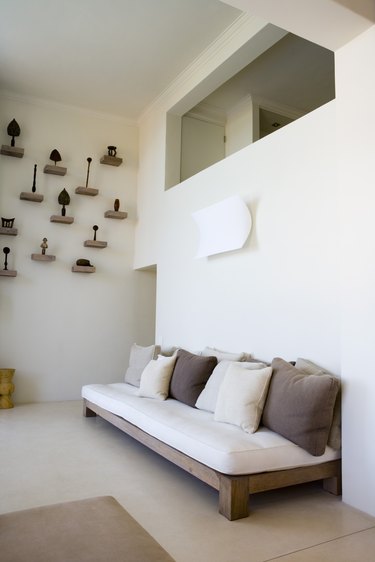
The term "raising the ceiling" soared to new heights in the late 1990s and early 2000s — literally. The trend toward large, upscale homes ushered in a demand for ultra-high ceilings. Although homebuilders see their clients' preferences moving in the other direction in 2011, a legacy of the McMansion era seems to be an increase in standard ceiling height from 8 feet to 9 feet, and ceilings of 10 feet and higher — sometimes much higher — are not uncommon. Although the dramatic vistas are impressive, high ceilings do have disadvantages.
Spaciousness
Video of the Day
Your eye follows the longest dimension in a room, regardless of whether the dimension is horizontal or vertical, according to "Log Home Living Magazine." If the vertical, floor-to-ceiling dimension is the longer one in your room, the horizontal, wall-to-wall dimension can seem narrower than it really is by comparison. This, in turn, can actually make the room feel smaller despite the open space above. Ultimately, the size of the room should determine ceiling height. An oversized room with a traditional 8- or 9-foot ceiling might feel closed in, whereas a small room with a twenty-foot ceiling might leave you feeling dwarfed.
Video of the Day
Comfort
Lack of intimacy is a frequent complaint about high ceilings. "Log Home Living Magazine" notes that people are most comfortable in spaces that are proportionate to their own sense of scale because it gives them a feeling of protection. "Psychology Today" adds that people take social cues from both the visual distance between them and others and the auditory distance -- how far away voices sound. High ceilings can make voices sound farther away, which reduces the sense of intimacy and comfort.
Energy Efficiency
High ceilings cost more to heat. Heat rises, so the warmest part of a room is at ceiling level. Thermostats measure temperature closer to the floor, however, so your heating system has to work harder and longer to fill the space with heat from the ceiling down. By the time the room is warm enough at floor level, it may be overly warm at ceiling level. Ceiling fans help push the warm air down, but you'll still pay for more heat than you benefit from.
Construction Costs
Building up is less expensive than building out, according to "The New York Times," because raising the height of the ceiling doesn't add to roofing and foundation costs like a larger footprint does. When determining costs strictly on the basis of ceiling height, however, higher is clearly more expensive. Constructing a high ceiling requires more building materials and more expensive items like oversized windows and trusses.